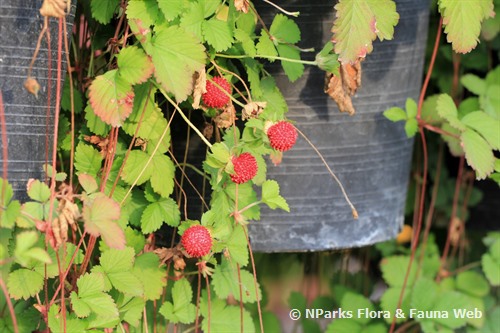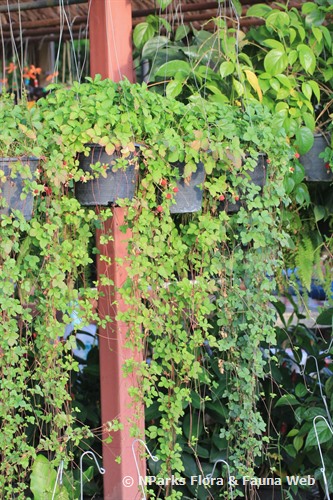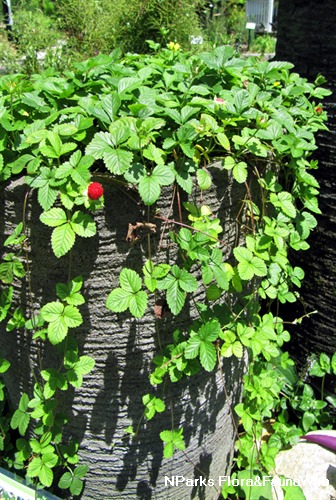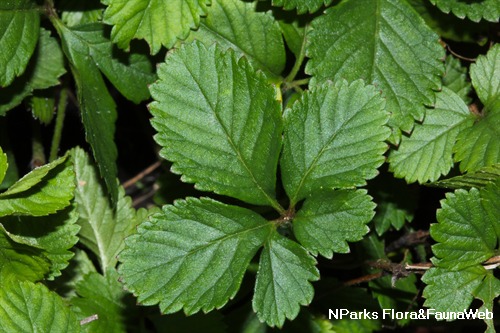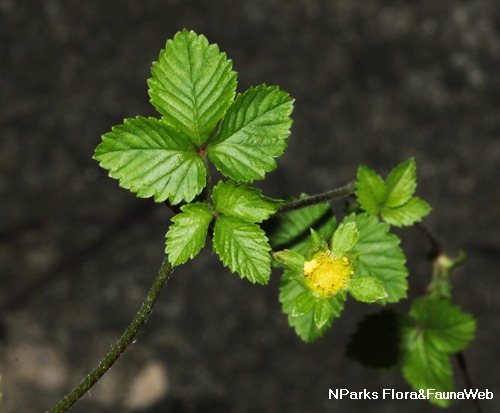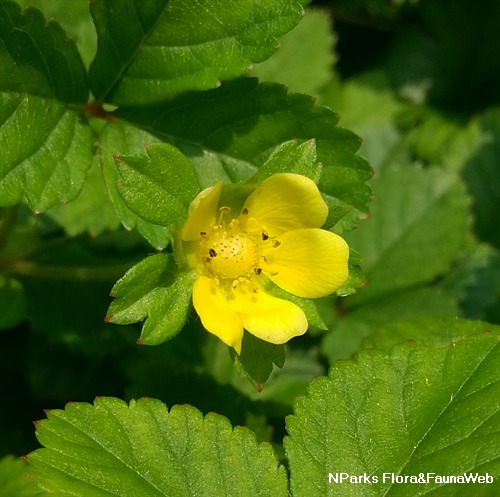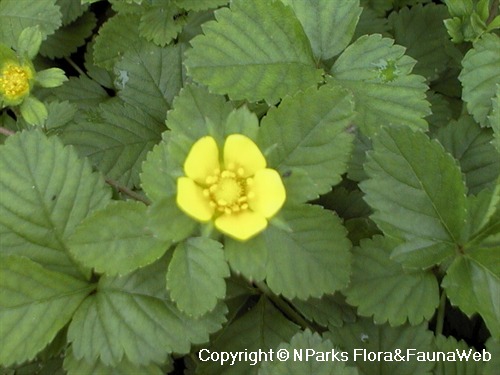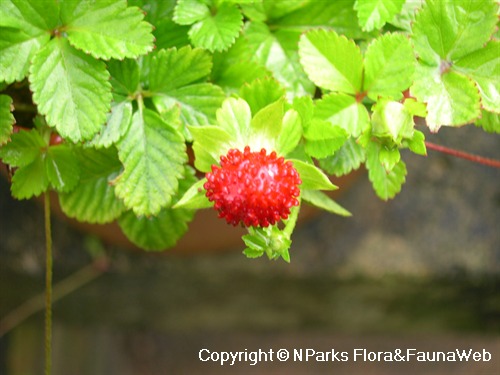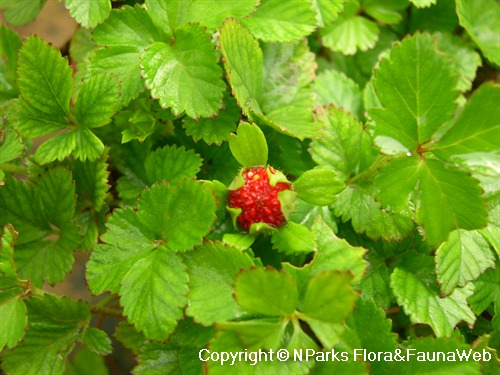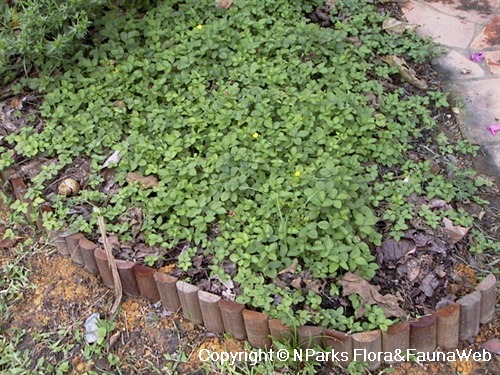
Back
Potentilla indica (Andrews) Th.Wolf
| Family Name: | Rosaceae |
| Synonyms: | Fragaria indica, Duchesnea indica |
| Common Name: | Mock Strawberry, 蛇莓 |
Potentilla indica is an herbaceous plant with bright yellow flowers and tiny red fruit resembling strawberries, hence its common name Mock Strawberry. Its fruit can be made into jam and jelly or eaten raw in salads and the trifoliate leaves can be steeped into herbal tea. This creeping plant grows close to the ground forming thick mats, ideal as a groundcover as it flowers and fruit all year.
Name
Classifications and Characteristics
| Plant Division | Angiosperms (Flowering Seed Plants) (Dicotyledon) |
|---|---|
| Plant Growth Form | Creeper, Herbaceous Plant |
| Lifespan (in Singapore) | Perennial |
| Mode of Nutrition | Autotrophic |
| Plant Shape | Irregular |
| Maximum Height | 6 cm to 7 cm |
Biogeography
| Native Distribution | Tropical Asia |
|---|---|
| Native Habitat | Terrestrial |
| Local Conservation Status | Non-native (Spontaneous (Naturalised)) |
Description and Ethnobotany
| Growth Form | Low-growing shrub with a creeping and trailing growth form. |
|---|---|
| Foliage | Compound leaves are composed of 3 ovate to elliptic leaflets with toothed leaf margin. Leaflets are sparsely covered in hairs. |
| Stems | The stems can grow more than 30 cm long and are sparsely hairy. This species has runners which are stems that lie along the ground and root at the nodes (the part where the leaves are attached). |
| Flowers | Solitary, yellow flowers are composed of 5 obovate petals with numerous short, yellow stamens (pollen-producing part). |
| Fruit | Fleshy, edible fruit resembles a small, bright red strawberry, but it is not juicy or flavourful. The fleshy portion is not a true fruit-- the seed-like structures on the surface are fruits known as achenes. |
| Habitat | In some areas of the USA, this species is considered an invasive weed. |
| Cultivation | It grows best in moist, well-drained soil. Sow seeds by lightly pressing them on the soil surface. |
| Etymology | The genus Potentilla means quite-powerful, for its uses as a medicinal herb. The species indica means from India, but for this species it is loosely used for its large native distribution. |
| Ethnobotanical Uses | Edible Plant Parts : Edible Fruits, Edible Leaves Food (Fruit or Vegetable) Others: The leaves are usually not consumed, but can be eaten raw or cooked, as well as used for herbal tea. |
Landscaping Features
| Landscaping | Grown as groundcover as well as in hanging baskets. |
|---|---|
| Desirable Plant Features | Ornamental Foliage, Ornamental Fruits, Ornamental Flowers |
| Landscape Uses | Suitable for Hanging Baskets, Groundcover |
| Thematic Landscaping | Wildflower Garden |
| Usage Hazard - Cons | Invasive / Potentially Invasive |
Fauna, Pollination and Dispersal
| Fauna Pollination Dispersal Associated Fauna | Bee-Attracting, Bird-Attracting (Fruits) |
|---|---|
| Pollination Method(s) | Biotic (Fauna) |
| Seed or Spore Dispersal | Biotic (Fauna) |
Plant Care and Propagation
| Light Preference | Semi-Shade |
|---|---|
| Water Preference | Lots of Water, Moderate Water |
| Plant Growth Rate | Fast |
| Rootzone Tolerance | Moist Soils, Well-Drained Soils |
| Maintenance Requirements | Low |
| Propagation Method | Seed |
Foliar
| Foliage Retention | Evergreen |
|---|---|
| Mature Foliage Colour(s) | Green |
| Mature Foliage Texture(s) | Smooth |
| Prominent Young Flush Colour(s) | Green |
| Young Flush Texture(s) | Smooth |
| Foliar Type | Compound (Trifoliate) |
| Foliar Arrangement Along Stem | Alternate |
| Foliar Attachment to Stem | Petiolate |
| Foliar Shape(s) | Non-Palm Foliage (Ovate, Elliptical) |
| Foliar Venation | Pinnate / Net |
| Foliar Margin | Crenulate |
| Foliar Apex - Tip | Acute |
| Foliar Base | Acute |
| Leaf Area Index (LAI) for Green Plot Ratio | 4.5 (Shrub & Groundcover - Dicot) |
Non - Foliar and Storage
| Stem Type & Modification | Runner / Stolon |
|---|---|
| Root Type | Underground (Fibrous Root) |
Floral (Angiosperm)
| Flower & Plant Sexuality | Bisexual Flowers |
| Flower Colour(s) | Yellow / Golden |
|---|---|
| Flower Texture(s) | Smooth |
| Flower Grouping | Cluster / Inflorescence |
| Flower Location | Axillary |
| Flower Symmetry | Radial |
| Inflorescence Type | Head / Capitulum |
Fruit, Seed and Spore
| Mature Fruit Colour(s) | Red |
|---|---|
| Mature Fruit Texture(s) | Bumpy / Tuberculate |
| Fruit Classification | Aggregate Fruit (Syncarp) |
| Fruit Type | |
| Mature Seed Colour(s) | Red |
| Seed Quantity Per Fruit | Numerous (>20) |
Image Repository
Others
| Master ID | 199 |
|---|---|
| Species ID | 5299 |
| Flora Disclaimer | The information in this website has been compiled from reliable sources, such as reference works on medicinal plants. It is not a substitute for medical advice or treatment and NParks does not purport to provide any medical advice. Readers should always consult his/her physician before using or consuming a plant for medicinal purposes. |



